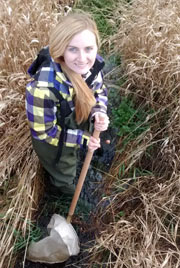Other duties, as assigned: The real scoop on being a conservation biology coordinator
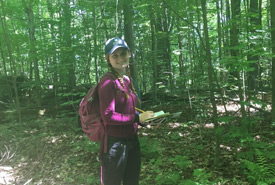
Megan Quinn working in the forest (Photo by NCC)
I finally did it! Back in 2016, on the last day of my conservation technician internship with the Nature Conservancy of Canada (NCC), I promised myself I would do everything possible to return to the organization, and here I am. I am the new acting coordinator of conservation biology for eastern Ontario. My title is kind of a mouthful, and I still wake up most mornings and pinch myself.
Over the past three months, I’ve been re-learning the ropes and the new responsibilities of this position. I caught a glimpse of what was coming during my internship, but the reality of running the stewardship activities for all of eastern Ontario is a learning curve.
I’ve remembered some things, like driving directions to some properties, the names of some great neighbours and the location of that log at Elbow Lake where painted turtles bask.
I’ve also re-learned a few things the hard way. For example, if you don’t cross the stream at exactly the right spot on the Freeman property, you’ll either be stuck on the wrong side or spend the day with wet feet.
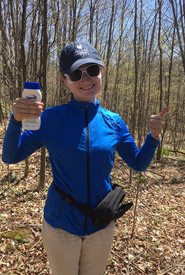
With my sun protection and bum bag, I'm the coolest conservation biologist in eastern Ontario (Photo by NCC)
There are also some things that are entirely new: properties, protocols and spreadsheets with budgets to track, actions to plan and concrete deadlines. I’ve recently discovered the wonders of using a bum bag (or fanny pack, as you Canadians call it) in the field. It may look silly, but it’s useful when you’re trying to carry your phone, field book, compass, pencil and GPS unit through a wetland.
As the scope of my job is fairly large, my friends have stopped asking me exactly what I do, and I don’t blame them. Over the past two weeks, my work duties have included:
- Exploring (and falling into) a wetland;
- Hiking up a rock barren that was so steep, my fitness tracker was convinced I’d gone up 54 flights of stairs;
- Camping in the woods after hosting a bioblitz;
- Successfully operating (and docking) a boat;
- Working on a massive spreadsheet to update the Natural Area Conservation Plan for the Frontenac Arch;
- Giving two TV interviews to talk about NCC’s recent acquisition of the Whitefish Lake property;
- Classifying vegetation communities;
- Monitoring numerous kilometres of trail;
- Identifying snakes, frogs, trees, caterpillars, ferns, shrubs, birds and several other species;
- Training conservation technicians; and
- Rescuing turtles trying to cross the road.
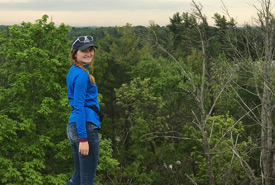
Exploring a rock barren (Photo by NCC)
It dawned on me that what I love most about my job is also what makes it the most challenging: every day is different. One day I’m in the forest, the next I’m in a wetland, then I might be in the office answering phone calls and planning Conservation Volunteers events, followed by a day on a rock barren. It’s hard to feel like an expert in something when your job involves so many duties, but luckily I have many resources.
I’m thankful to have a great team of conservation technicians helping me out. I may not remember exactly what species of flowering plant I’m looking at in a swamp, but between the five of us, we can usually figure it out. I’ve also returned to the books, pouring over field guides and listening to bird calls in my spare time to improve my species identification skills. Taking detailed notes and writing countless to-do lists has helped keep me on track, and I think I’m getting the hang of it.
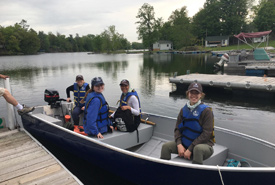
NCC's eastern Ontario team travelling by boat (Photo by NCC)
Last summer, I wrote a blog post about “coming home” to my NCC family, and I can’t deny the warm welcome I’ve received from colleagues, old and new. One thing that makes this job so great is the people who come together and help each other for the sake of nature and conservation. I’ll probably never know everything about the diverse ecosystems in eastern Ontario, and it’s a little intimidating to be taking over the reins of such a well-managed sub-region, but I’m learning more every day.
For now, I’m going to do my best to enjoy this wild ride of being a conservation biologist in eastern Ontario, and maybe pinch myself a few more times to make sure I’m not dreaming.

